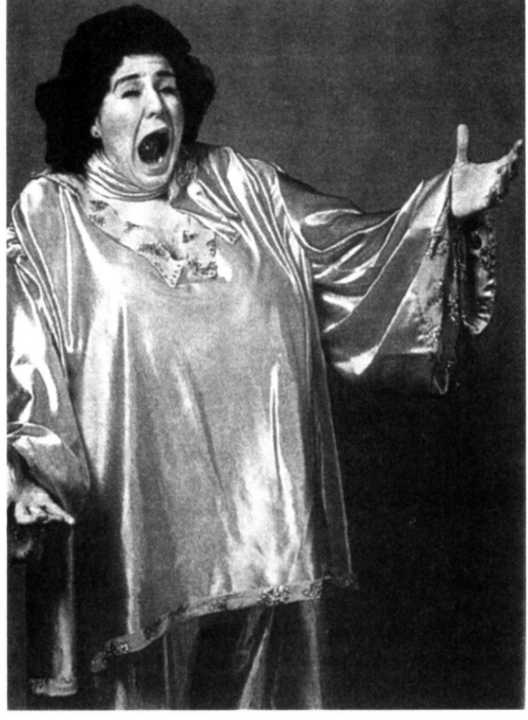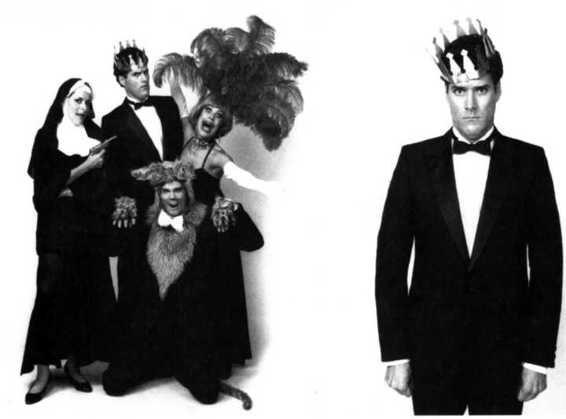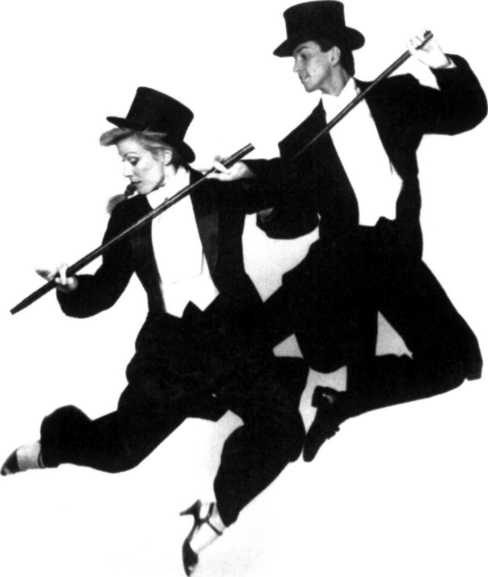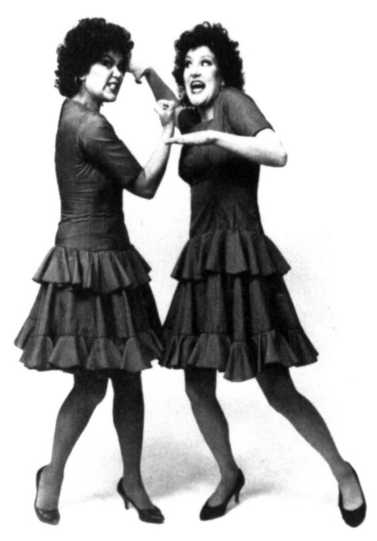Read Forbidden Broadway: Behind the Mylar Curtain Online
Authors: Gerard Alessandrini,Michael Portantiere
Forbidden Broadway: Behind the Mylar Curtain (16 page)

By that time, Jennifer Holliday was all the rage; she had won the Tony, although
Nine had won over Dream girls for Best Musical. They were both wonderful shows,
but Dreamgirls was spectacular and a mainstream triumph. There was a feeling that
Nine had sort of stolen the Tony. I remember being in a taxi headed to an interview.
We pulled up alongside a bus that had a huge poster on the side. It screamed "See
Dreamgirls!" I thought to myself, "We should call it'Screamgirls."' So I wrote a parody
titled "And I Am Telling You I'm Not Singing."
Chloe Webb was still in the show, and the Dreamgirls number turned out to be her
particular masterpiece. She really pulled out all the stops. We invented this huge pink
costume that was about eight times the size of Jennifer Holliday. As I remember, we
didn't really hesitate to have a white person play a black person. We were all in our
twenties and somewhat naive. Also, I had known Chloe since college, and she was never
very concerned about being politically correct. We may have become more sensitive
about that sort of thing later on. But Jennifer Holliday's performance in Dream girls
transcended race; she immediately became a theatrical icon, like Merman or Liza.

Chloe Webb as "Jennifer Holler-day" in "Screamgirls:'
Altogether, I think we added three numbers
to the show: 'Screamgirls,' a Cats number ("I Enjoy Being a Cat"), and a parody of "Be Italian"
from Nine, called "Be a Catholic." Once word
got around that there was new material in Forbidden Broadway, lots of people came back to
see it again. And from then on, we pretty much
followed that pattern.
I really enjoyed updating the show, and I
think the cast had a good time trying out new
material. We would change the order of the
numbers and switch off; I originally did the Rex
Harrison number, then Bill Carmichael took it
over, and so on. But it wasn't until later that I
decided to start doing whole new editions with
catchy titles.
In the spring of 1983, we thought we would
see how the show would play in other cities. So
Bill, Chloe, Fred, Dee Hoty (replacing Nora, who
was expecting her second child), and I went off
to do it in L.A. Jason Alexander joined the New
York company, as did Ann Morrison. Both had
recently co-starred in Merrily We Roll
Along-the show that had inspired our
original logo design. It became clear
that super-talented actors such as Jason
and Ann could keep the show going like
gangbusters.

Gerard Alessandrini at work, writing Forbidden Broadway.
In L.A., we did the show at The Comedy Store, but it was only moderately
successful. That really wasn't the best
venue for us, because we had to work
around the club's schedule. I remember that we couldn't do a show on Saturdays at 8:00 because Jim Carrey had
that spot. When we played in L.A. in
later years, it was in actual theaters,
and the show was a huge hit. There
is a theatrical community there, even
though it's much smaller than in New York. And by the time we came back to L.A., we had the imprimatur of being a hit in
New York, so that helped us bring in an audience.

1983: Ann Morrison, Jason Alexander, and Marilyn Pasekoff sing "Be a Catholic."
I remember that Vincente Minnelli, Robert Stack, and their wives came to see the
show twice. I wish I'd had the chance to talk with them more. When Minnelli came, I
thought, "Thank God we don't have a Liza number." But after he left, I started to think,
"Maybe we should have a Liza number." As soon as we got back to New York, I wrote
"Liza One-Note," and we put it in the show. Vincente Minnelli never came back to see
Forbidden Broadway again.
By the fall of '83, 1 was back in New York, and we had a fabulous new cast that included Marilyn Pasekoff, Ian Neuberger, and the supremely gifted Patrick Quinn in all
his glory. Patrick was one of the quintessential Forbidden Broadway leading men; he
had all the experience and expertise of delivering a big baritone performance but he knew how to heighten everything just enough to make it look absurd. He also oozed
a sense of, "I know everything about theater and I know who's sleeping with whom!"
Especially for Patrick, I wrote a parody of Alfred Drake, a legendary stage star who had
recently appeared in the movie Trading Places with Eddie Murphy.

Left: The cast of Forbidden Broadway '84 (clockwise from left): Marilyn Pasekoff, Patrick Quinn, Jan Neuberger,
and Doug Voet. Right: Patrick Quinn, as Richard Burton in Camelot, happily displays his $1.95 cardboard crown.
I wrote the Drake parody lyrics to Fred/Petruchio's songs from Kiss Me, Kate. Patrick knew those songs well; I believe he had performed the role himself once. In our
show, the first time he did the number, he entered in a tight lavender doublet, looking
ridiculous. He knowingly smiled ... and then proceeded to sing the entire song with
all of the original Cole Porter lyrics. His eyes glazed over, and I could see the sweat
dripping from his red face. With great bravado and impeccable diction, Patrick sang
"Where Is the Life That Late I Led?" to a very confused audience. He finished with a
big flourish, and with his doublet soaking wet. The audience sat there silently, but I
was doubled over in laughter.
Since there was so much activity on Broadway, we made a lot of changes to the
show and decided to present a new edition, titled Forbidden Broadway 1984. I finally
wrote that Liza Minnelli number, "Liza One-Note," and I loved setting my own lyrics to George Gershwin's music for our spoof
of My One and Only.
Even though I was back in New York, I
stopped performing in the show myself so
I could concentrate more on writing and
directing. Besides, how could 1 compete
with the likes of Jason Alexander and Patrick Quinn? I started to pay more attention to honing the show and routining the
numbers. It became clear how important
it was to place each number properly in
the running order, according to whether
it was broad or wordy or ballad-y, so everything would work in context. This remained true for the entire run; we would
go into rehearsal with fifteen new numbers, and it would take weeks to find the
right order.

Ian Neuberger and Davis Gaines, flying high as Twiggy and Tommy
Tune in our version of My One and Only.
One of my favorite numbers that I added to the show at this time was "Chita/
Rita." I had been searching for a good
idea for a spoof of Chita Rivera, whom I
consider to be one of the greatest stars
in Broadway history. I spent hours listening to her cast albums, and while West Side Story was playing one night, I
began to remember her club act, which I had seen several
years before. Then I thought, "Wait a minute, that was Rita
Moreno's act. No, it was Chita. No, it was Rita. Chita! Rita!"
To this day, I'm not sure whose act it was. But as my thoughts
bounced back and forth between their names, the song
"America" was playing on the stereo, and all the words fit
perfectly.

Sue Terry as Chita and Roxie Lucas as Rita. Oh
no, sorry; that's Sue as Rita and Roxie as Chita.
Or maybe it's the other way around ...
When I handed the parody to the girls in the show, they
went wild with enthusiasm, and Fred Barton said, "This is
exactly what the doctor ordered." The girls' joy was shortlived when they tried to memorize some of the wordiest lyrics
I'd ever written. I had even put words to Bernstein's dance
music. (I thought, "That'll show you, Steve Sondheim!" I was
young.) There wasn't a moment of rest in the number, but
everybody's hard work paid off.
When Forbidden Broadway originally opened, it wasn't very polished. You might
even say it was sophomoric. The show was a hit because it was so outrageous; nobody
had seen anything like it, and we performed it with unabashed commitment. But by
1984, the show started to have an arc to it. We had so much fun at Palsson's in those
days. It seemed as if every Broadway star came to see us, along with other major celebrities, and they would hang out afterwards and talk with us-people like Jeremy
Irons, Maggie Smith, Mary Tyler Moore.
I don't know how much of this was due to the success of our show and how much
to the fact that the Upper West Side was becoming more trendy, but Palsson's became
a real celebrity spot. Liz Taylor came in one night after The Little Foxes, wearing a
full-length white ermine cape with a dragon embroidered on the back of it. Cher
would show up after Come Back to the Five and Dime, Jimmy Dean, Jimmy Deanand she'd still be in costume. You could go to Palsson's after our show and see Al
Pacino, Robert De Niro, Robin Williams, Raul Julia. I remember that Sella Palsson
was a little overwhelmed to have mega-celebrities like that in the club. It was a small
place, and the staff just wasn't used to it.
